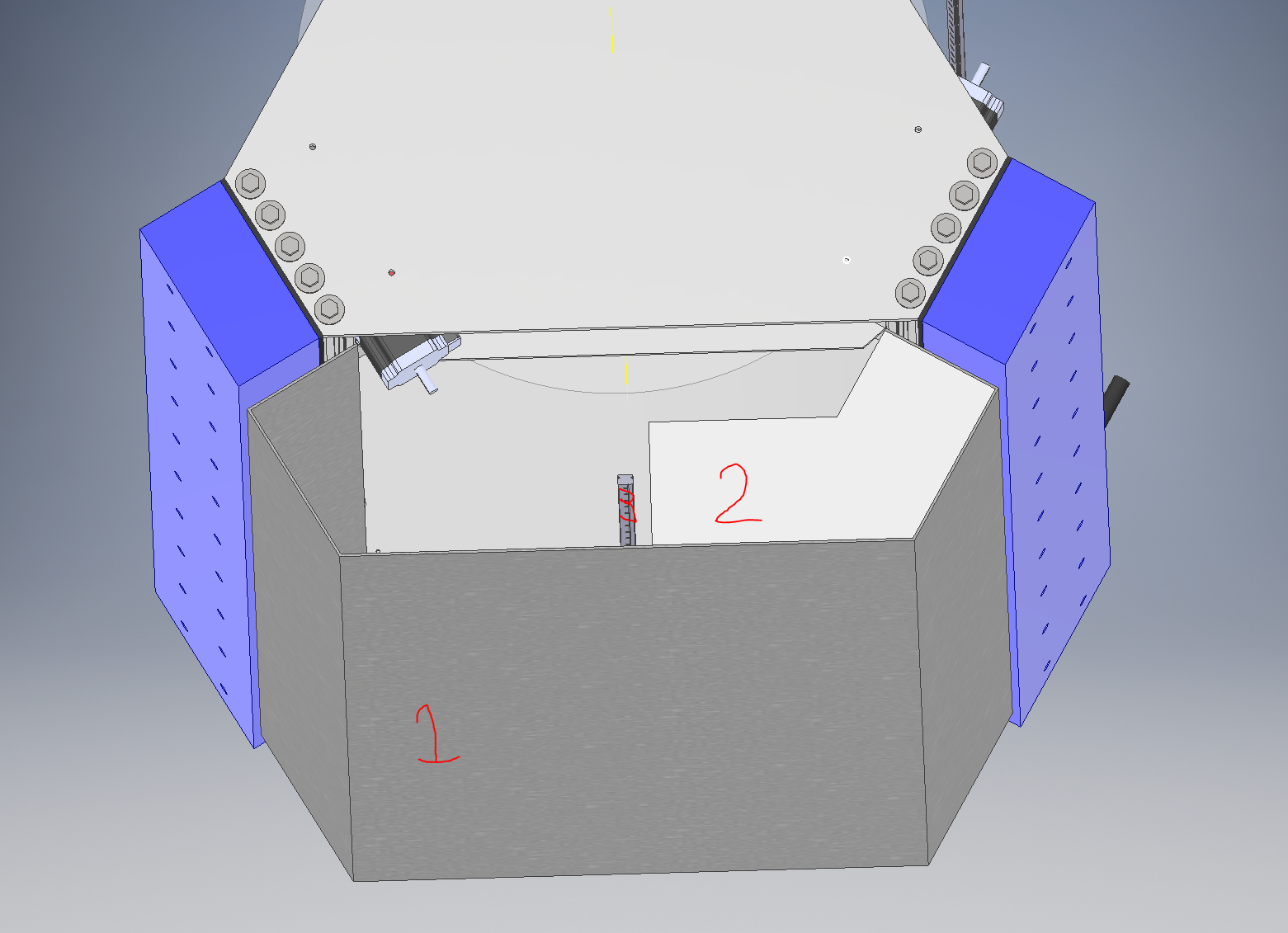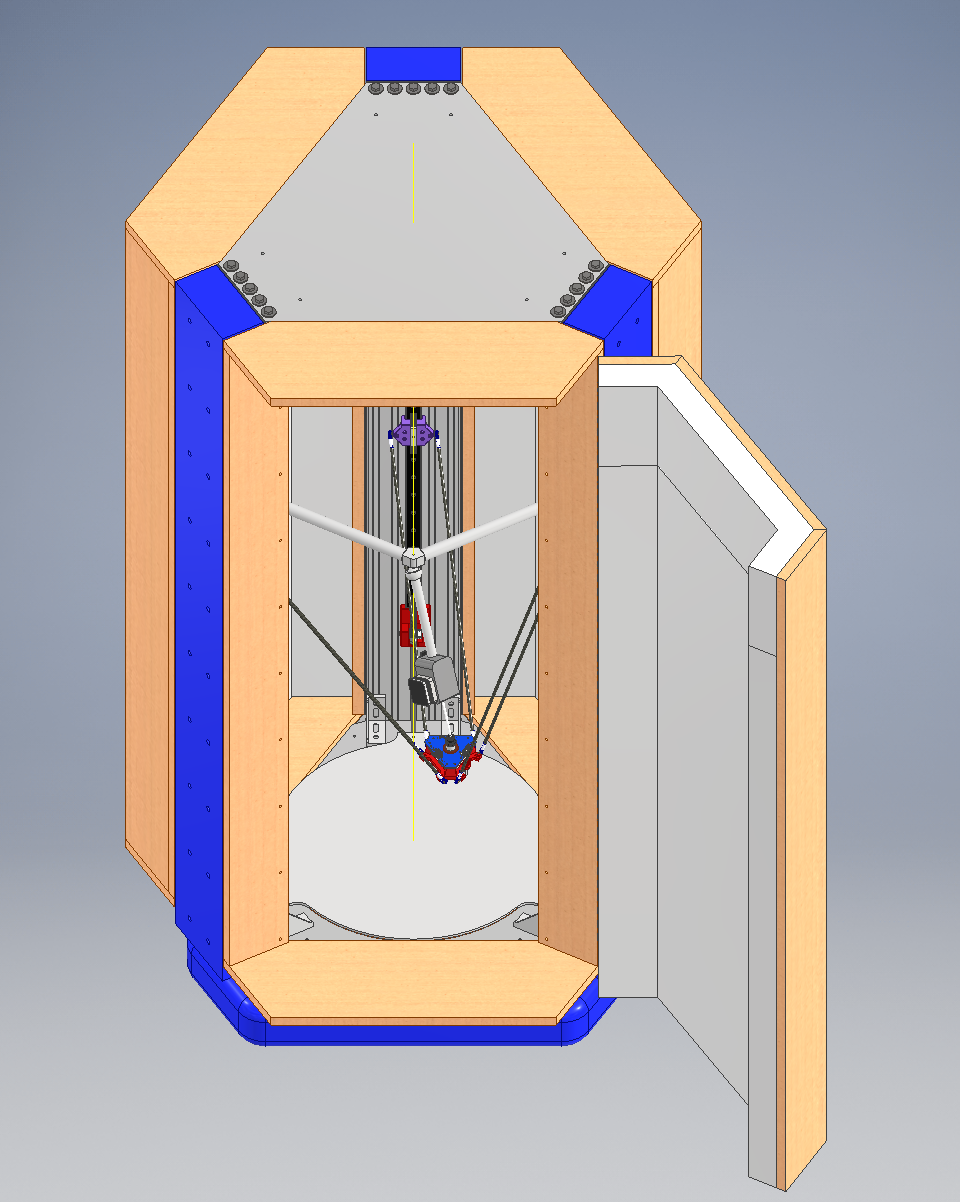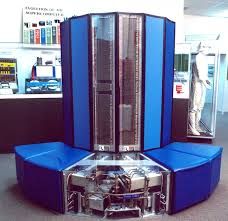Building a Sound Dampening Enclosure
-
What do you guys think? For me the ideal solution would the one incorporating the 4th axis, while still having the structures removable via bolts or something alike. A permanent weight increase is out of the question as the machine already is at the limit of what can be considered movable weight.
-
Oh and one more point in favor for the integrated approach, heat. If I go with the easy box style then the whole becomes one big heated chamber, with the integrated I can at least try to keep the hot section contained to just the build area.
-
I have been playing around with the idea some more and at the moment a fabricated steel back is what I have in mind.
The outer shell (number 1) consists of 2, maybe 3mm thick steel and is welded from flat steel plate. I have no metal brake to bend it and more importantly, it would be a nice project to hone (or rather rough) my welding skills. The steel is bolted to 30mm sides of the towers. The insulation (number 2) is two layer of 50mm thick material stacked on the inside. On the picture, just half is shown. The linear rail (number 3) would be attached directly, or with something like an aluminium extrusion inbetween, to the steel outer frame.
It's hard for the gauge how stiff this steel shell would be, which is important as it locates the 4th axis rails. Equally important, I need to be absolutely sure that I do not create another vibrating metal surface like the towers were before the added concrete.

-
I'd personally shove it in a double box lined with sound insulation (inside of the inner box with those pyramidal sponge - but the kind that works, not the cheap useless PRC crap, and then between two boxes something like azmaphone) but I'm not sound engineer
 ... now, we do have sound engineer on forum! @omni might chime in with some ideas
... now, we do have sound engineer on forum! @omni might chime in with some ideas 
-
@arhi said in Building a Sound Dampening Enclosure:
we do have sound engineer on forum!
... when you click a profile on a 3d printing forum an think "oh, nice rack!"... /blush/
-
@arhi I believe a double box is no longer needed in my case. As far as I know the reason to go double is to decouple the vibrations from the floor the machine is sitting in. Thanks to previous efforts (epoxy granite base, sitting on purpose made decoupling feet), I believe I already have sufficiently decoupled the machine.
I definitely agree with using proper absorbing materials. Currently I am looking at Akotherm from Merford, still debating whether to do with the D20 or the heavier D40 variant. With either one, a total of 100mm thickness should give me very good performace, at least according to the datasheets.
I'd love to hear what someone with experience in the branch has to say for sure!
-
Depends. If you will make a panel with steel on both sides, then you will have better results with the lighter insulation.
That way you really decouple the sheets, if you use a stiffer one it could happen that you transfer the sound from inside to outside.
You can also benefit if you put thinner sheet metal on inside (or outside). The difference in the natural frequency helps dampening. -
@Nxt-1 said in Building a Sound Dampening Enclosure:
@arhi I believe a double box is no longer needed in my case.
Dunno, I don't know much about sound so when I soundproof stuff I have to overdo it
 and this was successful for me .. inside foam with pyramids looks good and absorbs a lot, then whatever go trough is catched by the azmaphone (looking at datasheet, similar to akotherm) .. very important to have everything pretty airtight and it works good... now if this is not enough, add anouther layer, and another and .. till you happy
and this was successful for me .. inside foam with pyramids looks good and absorbs a lot, then whatever go trough is catched by the azmaphone (looking at datasheet, similar to akotherm) .. very important to have everything pretty airtight and it works good... now if this is not enough, add anouther layer, and another and .. till you happy 


-
Ok so now your aim is, quite rightfully (!), to get rid of the noise emitted from your printer. We're talking about air in this case and what you now want is:
- A box around it that does NOT touch the printer! In fact you want to de couple even more, see below.
- want the box to be air tight. So think about cooling air (ducts) for electronics etc. Make it as tight as feasible and the hands you need: try isolation material here that let air through.
No need for stiff as air really has a hard time to excite any material, so some foam is more than enough. Or MDF plates or something. I would not work with steel as it doesn't damp well. MDF is better in this case!
But the box and printer both touch common ground and it's through this "path" vibration can transmit to the box and the box...
So think about isolating the box to your desk it's standing on. Is the printer de coupled actually from your desk? By itself might also bring a lot.
Look forward to your design and progress!
-
@QuintBrand said in Building a Sound Dampening Enclosure:
Ok so now your aim is, quite rightfully (!), to get rid of the noise emitted from your printer. We're talking about air in this case and what you now want is:
- A box around it that does NOT touch the printer! In fact you want to de couple even more, see below.
- want the box to be air tight. So think about cooling air (ducts) for electronics etc. Make it as tight as feasible and the hands you need: try isolation material here that let air through.
No need for stiff as air really has a hard time to excite any material, so some foam is more than enough. Or MDF plates or something. I would not work with steel as it doesn't damp well. MDF is better in this case!
But the box and printer both touch common ground and it's through this "path" vibration can transmit to the box and the box...
So think about isolating the box to your desk it's standing on. Is the printer de coupled actually from your desk? By itself might also bring a lot.
Look forward to your design and progress!
I agree that decoupling more is always better and you are right that if there is a path then it is trough the floor. But as is stated before, I feel that I already have the decoupling pretty well done.
Also maybe I need to point out the scale of the machine as it is not standing on a desk. The machine is a little over 1,5m tall and already weighs about 200kg.

-
@QuintBrand Also, I have thought about going the MDF route, which would be a solid candidate if all angles were 90°. If I go the integrate route, which I am still leaning to, there are 90° angles, but also 120's which would be an absolute pain to construct properly with the tools I have available.
-
@Nxt-1 said in Building a Sound Dampening Enclosure:
@QuintBrand Also, I have thought about going the MDF route, which would be a solid candidate if all angles were 90°. If I go the integrate route, which I am still leaning to, there are 90° angles, but also 120's which would be an absolute pain to construct properly with the tools I have available.
Do you have a circular saw? Normally they have a adjustable plate, allowing you to make bevel cuts. And obviously you can use printed brackets to hold it together.
Personally I'd use MDF, or maybe chipboard. You want volume for sound damping, steel I'd be worried about being too stiff.This is turning into one of those building a boat in the attic stories.

-
Radio silence for a while but a lot has happened and more will happen very soon.
About a week ago I had my mind set on going the integrated route using 3 or maybe 2mm steel plates that I would weld. A fear was in the back of my head that this would be a sure path a more resonating surfaces (ie the steel) but my eagerness to weld something and possibly maybe have a chance at improving my welding skills while I am at it, was a strong argument for me

Long story short, to use steel plate cost effectively, you need to use standard dimensions in your designs, or use large plates and cut them optimally to suit your needs. Seeing how some of the back panels I need are sized roughly 140x45cm, and several other long pieces, I would need to go to something like a 3000x1500cm plate to use them effectively. Now may it be that I have no way of moving plates that size, nor do I want to pay for a large transport carrier to drop them off.
So after all, MDF enclosure here I come. I adapted and completed the design and below you can see what I came up with. I went to my local hardware store, got all the pieces I need cut nice and straight out of 18mm MDF and picked the wood up today. Simultaneously I figured out how many sheets of the Akotherm sound absorbing material I needed and, received them today as well. I went with 1 sheet, 50mm thick, D40 (the heavier variant) on all internal surfaces. With the idea that I designed room for a second layer if that proves necessary, as the plates are not exactly cheap.
I plan to assemble the wood structure and line the Akotherm over weekend. But before I do that I do plan to prime the wood and paint the outside. What color would you guys pick? I think blue would be the obvious color, but I think it will become a blue overload then


-
As I said, yesterday and today was assembly/painting day. I applied one coat of primer on all surfaces just kind of seal the surfaces and make them dust free. All surfaces that I planned on actually paint in color got a second coat of primer. After that, I put a single coat of color on there. I chose what the manufacturer calls 'concrete' color, yet it does not look anything like concrete but whatever

Tomorrow, once its all dry, I'll see how good the result is with the single top coat. Assuming it's decent I will test fit the covers and see how it works out. I think I am going to wait with installing the sound dampening panels until the aluminium extrusion that the 4th axis rail attached to, arrives. And the 4th axis design I am working on is all finished up.Oh and god I hate painting








-
@Nxt-1 said in Building a Sound Dampening Enclosure:
Yet the noise levels are not down to what is acceptable for me.
FYI, Installing the x/y/z steppers on dampers reduced significantly the noise from my printer. Others reported similar success. It prevents the vibrations to propagate to the frame.
https://www.amazon.com/BIQU-Stepper-Vibration-Dampers-Printer/dp/B07GWN6V8
-
@zapta said in Building a Sound Dampening Enclosure:
@Nxt-1 said in Building a Sound Dampening Enclosure:
Yet the noise levels are not down to what is acceptable for me.
FYI, Installing the x/y/z steppers on dampers reduced significantly the noise from my printer. Others reported similar success. It prevents the vibrations to propagate to the frame.
https://www.amazon.com/BIQU-Stepper-Vibration-Dampers-Printer/dp/B07GWN6V8
I had not written about it at the moment you posted but I am using proper dampers since a couple weeks now. Check my comment in the original vibration issues thread.
-
If it doesn't work you are good to go for I nice loudspeaker NXT!
This must work though! Cheers
-
The progress is going slower then I would like, lets hope slow and steady does the trick. I am waiting on an order from Motedis for some extrusions for over a week now. Some other stuff like magnets and water cooling items are still on their way too.
Meanwhile I did glue the one of panels, the door to be specific. Doesn't like very polished, but I can't really be bothered at this point, especially for something that you cannot see when it's in use. On the door panel I 'just' have to cut out a piece of the bottom so there is clearance with electrical outlets on the machine base and cutout some slots where I am going to epoxy in some magnets to keep the door shut.

-
Finally an update!
I have been working tirelessly for the past couple of day I can say that the enclosure is complete. Especially from the inside it does not always look the cleanest, but hey, I don't really care hehe. On a less positive note, it does not preform as expected, not at all. Even with the door closed the noise reduction is slightly noticeable but to be honest, negligible sadly. The enclosure will surely still serve as a barrier to keep the heat in and possible cold breezes out, as well as a mounting structure for the 4th axis rails.
Maybe of interest to some, each panel weighs between 15 and 30kg. They are not identical, as one is a door and one has a large water cooling radiator bolted to the back of it.
On the positive side, I have isolated two 'new' noise sources of which I have already resolved one. I'd like to keep this thread on topic so I will start yet another one to talk about it in detail. Come along for the journey: https://forum.duet3d.com/topic/18281/battling-sources-of-vibration-and-noise



-
